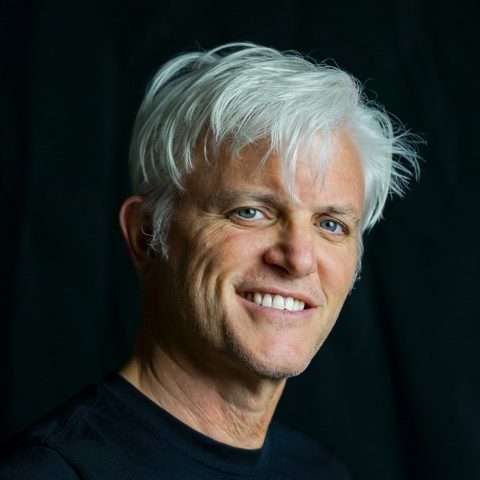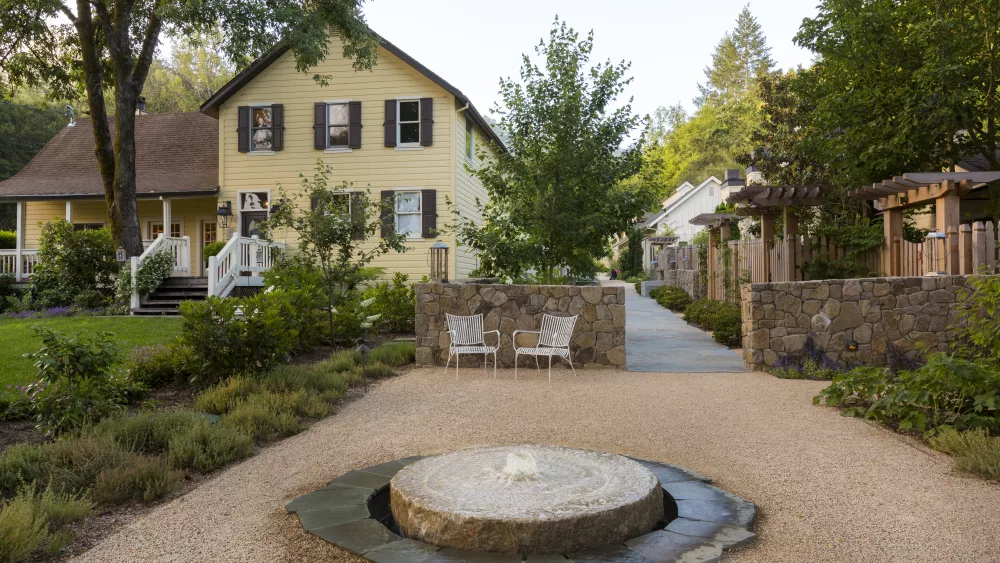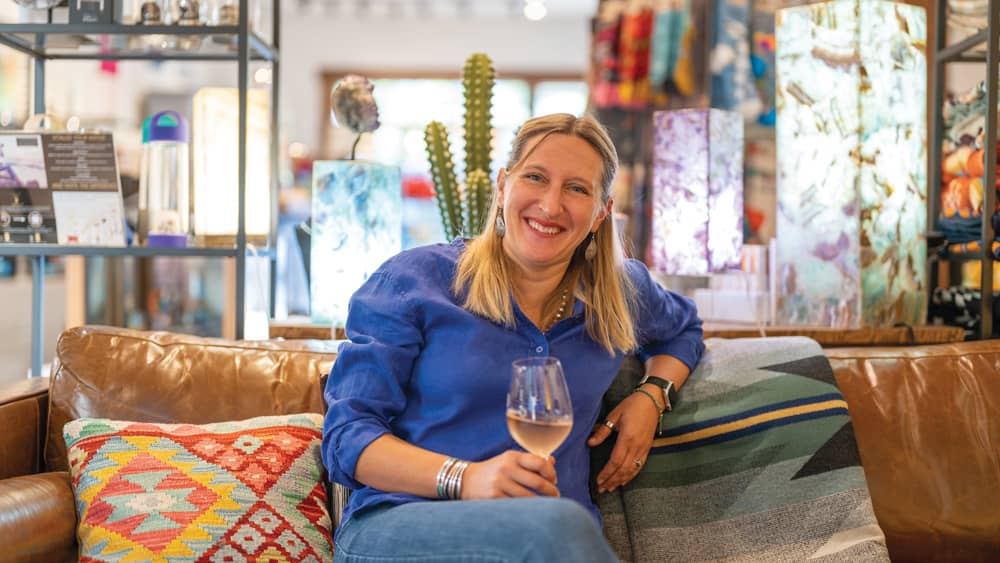
Meaning “a little bit” in old French dialect, Claire Ducrocq Weinkauf pays homage to her roots with her wine brand Picayune. More than a label, it also serves as an allegory for her approach to life. While seeking balance in all things, she feeds from her many travels and flux of eclectic input. “Wine is an important part of my story, but it’s only one part,” she says. “Family, community, friends and connection with nature and pursuing my dreams are all intertwined.”
Exploring the world
Born in rural France near the village of Thiers, Ducrocq grew up surrounded by good food, wine and family outings. Her father worked at the local Michelin tire plant and hunted, bringing home plenty of venison, wild duck and partridge. One of her mother’s passions was tending the family’s large year-round garden, growing everything from green beans and fresh peas to potatoes and tomatoes. On weekends, Ducrocq might forage with her grandparents, searching for porcini mushrooms, chestnuts, myrtilles (wild blueberries), raspberries or walnuts, the meat of which might be eaten or milled into fresh oil.
“I’ve shelled a lot of walnuts and peas in my life,” she says, and then laughs. “After school, there were always plenty of chores to do around our home, and many of them centered around food and wine. I didn’t think much about it at the time, but now I realize just how big an influence each of those small moments were.”
Pursuing a career in international business, in 1998 Ducrocq received a degree in marketing followed by graduating from the Toulouse School of Management in 2002. While she was in graduate school, an internship with the French Government Tourist Office brought her to New York City, which gave her a chance to travel widely throughout the United States. “I was just amazed at the diversity of this place,” she says. “Going from Texas to California was like two completely different planets, each with its own unique cultures and environments.”
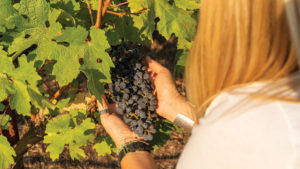
But before she would eventually make America her home, she initially wanted to explore more of the world, first finding work in Chile in the importing and exporting department of a manufacturing plant. It was also at this time that the idea of making wine—or at least being involved with the selling of wine—began to intrigue her. “At that time, at least in France, if you didn’t come from a family who made wine or grew grapes, making wine was just not even considered a viable career option,” she says. “But in Chile and America, there were people who were starting their own wineries from scratch. It was eye-opening.”
Always the one to be doing multiple things at once, while in Santiago she earned a diploma of marketing de los vinos (wine-marketing) and spent harvests in France, where she interned in the Rhone at Domaine des Rosier and in St. Emilion at Château Haut Sarpe, a Grand Cru Classé winery.
Eventually, back in Chile, she found her way to Odfjell Vineyards, a winery known for pioneering organic and biodynamic agriculture. At the time, Ducrocq was still on the marketing side of the business, but a chance encounter with Paul Hobbs, a winemaker and international consultant based out of Sebastopol, began to change her focus from strict sales and marketing to considering creating wines herself.
“Claire admired how Patagonia’s founder, Yvon Chouinard, saw the world: risk taker, innovator, adventurer; playful at heart with a sweeping desire to do good,” Hobbs wrote in an email. “In retrospect the handwriting was there at the time [that Ducrocq would eventually become a winemaker], so it was just a question as to how it was going to play out.”
In 2005, she spent time working at Viña Cobos in Argentina, and in 2006 she moved to Northern California to join the Paul Hobbs team full time. “It was an exciting time,” she recalls. “I was learning a ton about so many wines, styles and approaches. Sitting alongside Paul and his Argentinean team, while they’d go through the blending process is something that I will never forget.”
From Paul Hobbs, Ducrocq would then help open Long Meadow Ranch’s Farmstead Restaurant and Tasting Room in St. Helena before launching her own Claire de Lune Wine Marketing Consulting firm in 2010, assisting high-end boutique wineries such as Matthiasson Wines, Anomaly Vineyards, Morlet Family Vineyards and others. She also increasingly desired local high-quality wines at more affordable prices. “I completely understand how expensive it can be to make quality wine in this part of the world, but I also know how nice it is to have a few less-expensive options for those people looking for everyday wines,” she says. “Affordability is part of the philosophy behind Picayune, and one way we achieve that goal is by not owning our own winery or vineyards. We basically follow the classic French négociant model of winemaking and pass those cost savings along to our customers.”
In 2011, DucrocqWeinkauf and her then-business partner (Jennifer Roberts, wife to Nathan Roberts, co-owner of Arnot Roberts winery in Sonoma) purchased 17 barrels of Sauvignon Blanc, almost on a whim. “The wine was just too good to pass up,” she says. “But then we had all this wine and needed to get it bottled, labels made, come up with a name and everything else that goes into launching a new wine brand. It was a little crazy.”
What’s in a name?
The name Picayune has several meanings—“a little bit” in French, but it also refers to a Spanish coin worth half the value of the real (meaning royal), so it tied in with the idea of affordable pricing.
“The name just felt right — it touched on many of the ideas about why we started the brand in the first place,” she says. “We put a key on the label to signify access to something that is often hidden away, inaccessible. It’s not only about price, but also showcasing some amazing wines whose origins must remain mysterious due to contractual obligations.”
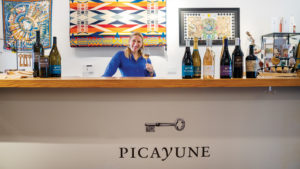
Ducrocq Weinkauf bought out Roberts’ shares in 2015 when she transitioned from strictly making wine into a business that included a retail shop and tasting room in what is now the brewery building at the Calistoga Depot. In 2019, the shop expanded, moving down the street to what had been the home of the Carmel Photo Gallery. The new space allowed the expansion of retail offerings to include French-made cutlery from her home region, jewelry, woven items and paintings, South American art, locally made wares and plenty of other items that symbolize the Picayune ethos of a little bit from here and there. “People ask me all the time why we sell so many different kinds of items,” she says. “Each has its own story and speaks to me, so I guess that’s the common thread.”
Beyond wine, tastings and retail, the offerings at Picayune now include live music on weekends, customized luncheons and yearly weeklong excursions to France with Ducrocq Weinkauf as the guide.
Picayune Excursions
Wine Members Only
Every year, Claire Ducrocq Weinkauf hires a barge that travels through the French countryside carrying her 20 wine-member guests, each of whom pays $3,500 (not including airfare). The weeklong adventure includes meals, wine and daily excursions that range from exploring wine regions to having a picnic in Versailles’s garden.
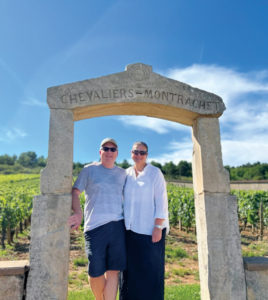
Much of the success of the trips, he says, has been largely due to Weinkauf. “Her attention to detail and her enthusiasm for sharing knowledge and experiences make travel so rewarding,” he adds.
And beyond watching the beautiful countryside glide by at 5 mph from the barge rooftop patio, highlights have included visiting historic Champagne houses and Burgundy wineries—from large to small family-run estates—while they learned the details of the various methods of viticulture and winemaking.
“We have learned so much from Claire and the various hosts and guides who have led us through all the nuances and granularity of the Burgundy and Champagne regions,” says Gary. “We have gained a new level of understanding and appreciation for the unique wines, as well as the history and traditions associated with those historic areas. We recognize there is much more to learn and discover, but that is the beauty of the awakening of travel and the guidance from someone such as Claire who points out the nooks and crannies for us to see and explore.”
Artisans
Beyond wine, Claire Ducrocq Weinkauf’s eclectic interests are on display at Picayune’s mercantile shop in Calistoga. Items for sale range from clothing and trinkets to custom-made cutlery.
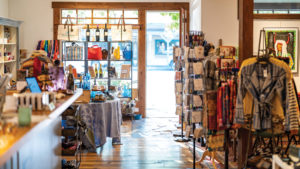
“Claire is driven in the very best way, so creative, very energetic and enthusiastic — she has a knack for marketing and merchandising, as evidenced by the incredible array of offerings in her store,” says Beth Novak Milliken, president and CEO of Spottswoode.
The store also includes a range of Native American jewelry and art, some of which is made by Terrance Guardipee, an internationally acclaimed Pikuni (Blackfeet) artist. Guardipee’s art depicts his tribal heritage. His pieces are often painted on antique pages of 19th century ledgers —such as accounting, tax, hotel and grocery—that were originally created somewhere within the Blackfeet homeland of Montana.
Ducrocq Weinkauf first became enamored with Guardipee’s art while on a trip to New York City. Taking a break from selling wine, she visited the Smithsonian’s National Museum of the American Indian to attend the “Unbound: Narrative Art of the Plains” exhibition. “I was immediately struck by how beautifully inspiring his work was,” she says.
Later she met the artist again when Guardipee was showing his work at the American Indian Art Show in Marin. The two became fast friends.
Guardipee has been creating ledger art since the 1990s. It is typically found in museums world-wide, private collections or at numerous Native American-focused art shows, including the largest, the Southwestern Association of American Indian Art’s annual event held in Santa Fe, New Mexico, every August. “I don’t often sell my work at private galleries like Claire’s, but she’s a good friend and I like what she’s doing,” says Guardipee.
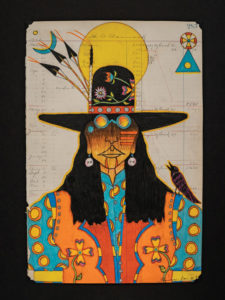
Ledger art evolved from buffalo-hide paintings. However, as the buffalo were hunted to near extinction, the animal skins were replaced by paper, canvas and muslin. These were often obtained from accounting ledger books that were a common source of paper for Plains Indians during the late 19th century. Ledger-art works often celebrate culturally significant events, aspirational visions and acts of courage.
According to Guardipee, between 1850 and 1910 ledger art was a thriving art form for the people of the northern and southern plains. It lay dormant until 1998, when he and a small group of Native American artists revived the practice. “The art celebrates power, strength, beauty and spiritual connection,” he says. “Everything in the work is real, accurate to the history and tells a story of truth and the search for connection with the Creator.”
Because each piece of Guardipee’s work is original and contains its own complex story, he has created videos that help to explain the details of every canvas he sells.
“We believe in the earth, the sky, the stars and of courage, strength and of all the gifts we’ve received to walk this path,” he says. “Everyone is on their own journey, but having good guides never hurts.”
The Wines
Picayune offers more than a dozen different kinds of wine, including an imported Grand Cru Blanc de Noirs Champagne sourced from the villages of Ambonnay, Bouzy, Louvois and Aÿ. All the Picayune wines display a lively, fresh and balanced profile that speaks to enjoying them alongside food and friends. The following four wines showcase the range of Claire Ducrocq Weinkauf’s approach.
The 2021 Hay Penny Rosé ($22 a bottle) is a sunset in the glass with aromas of peach, cantaloup melon, citrus rind and strawberry flowers. A blend of Syrah and Grenache, the grapes that make this wine originated from the Sierra foothills. This wine is light and bright and makes for an excellent addition to ceviche or oysters with mignonette sauce or with a squeeze of lemon.
The 2021 Albariño ($34 a bottle) is straw gold with golden apple, mango, honeycomb and ripe apricot aromas erupting from the glass. Sourced from grapes grown at the Rusty Gate Farm in Russian River Valley, this wine can pair well with everything from a simple crisp salad with grilled summertime vegetables to accompanying a rich cheese plate that includes Saint-Nectaire, a cheese made in the Auvergne region of France, near where Weinkauf grew up.
The 2020 Sonoma Coast Pinot Noir ($35 a bottle) is a medium-bodied wine with aromas of ripe cherry, Chambord and Chanterelle mushrooms. One of Picayune’s more complex wines, it screams to be paired with the likes of roasted lamb loin marinated with garlic and fresh rosemary or braised osso buco served with risotto Milanese.

The 2019 Padlock is a blend of Bordeaux grape varieties including Cabernet Sauvignon and Merlot. This wine is dark and brooding with aromas of dry plum, blueberry jam, tilled earth and dark chocolate. It would make a wonderful addition to any barbecue. If you’d like a more classic dish with which to pair this wine, try wild mushroom Vol-au-Vent.
“One of my greatest joys is hearing people enjoying themselves, laughing and talking around a table,” says Ducrocq Weinkauf. “My hope is that all the Picayune experiences provide opportunities for just such moments.”


